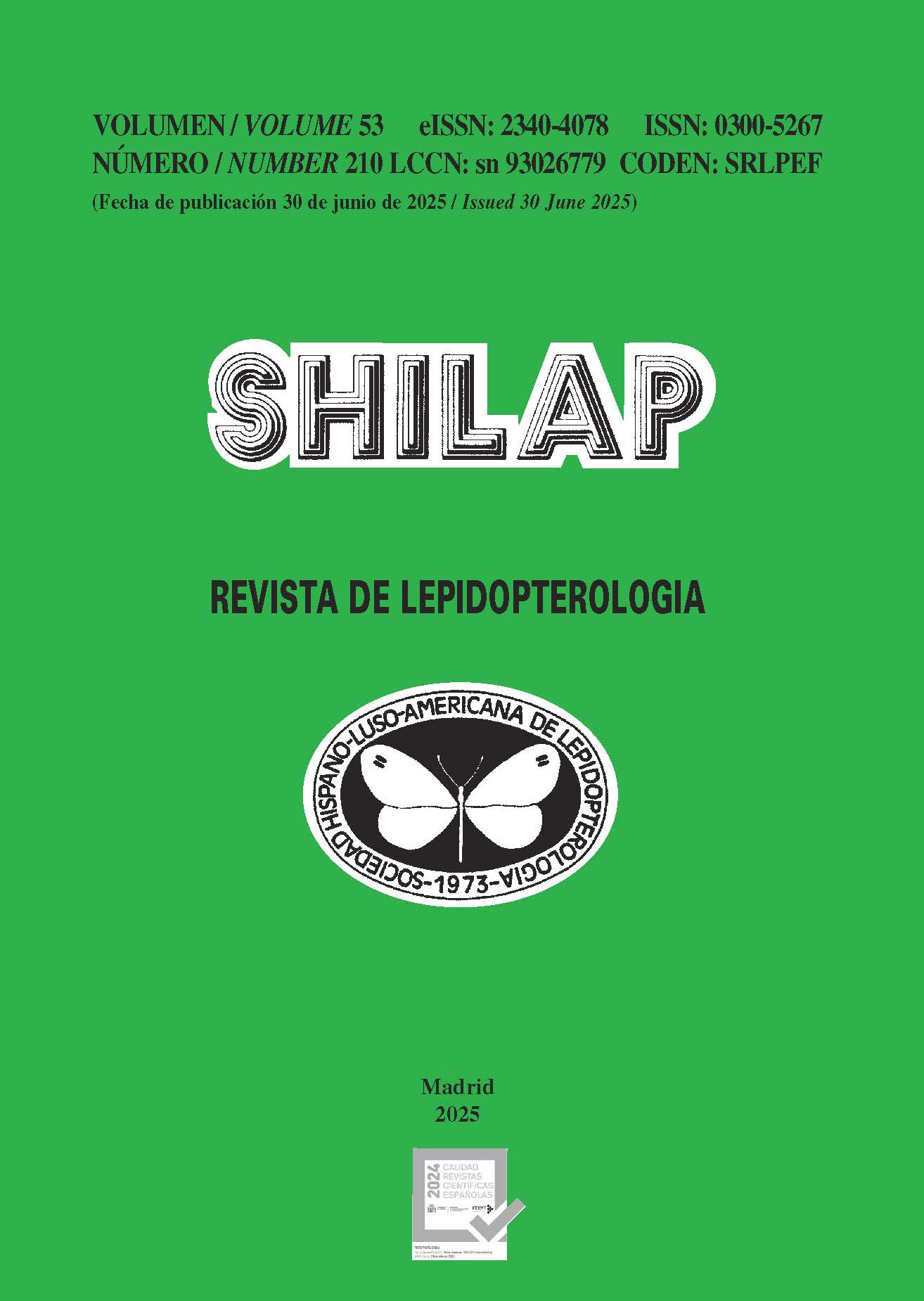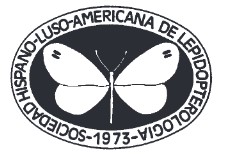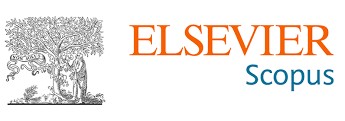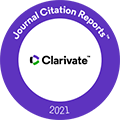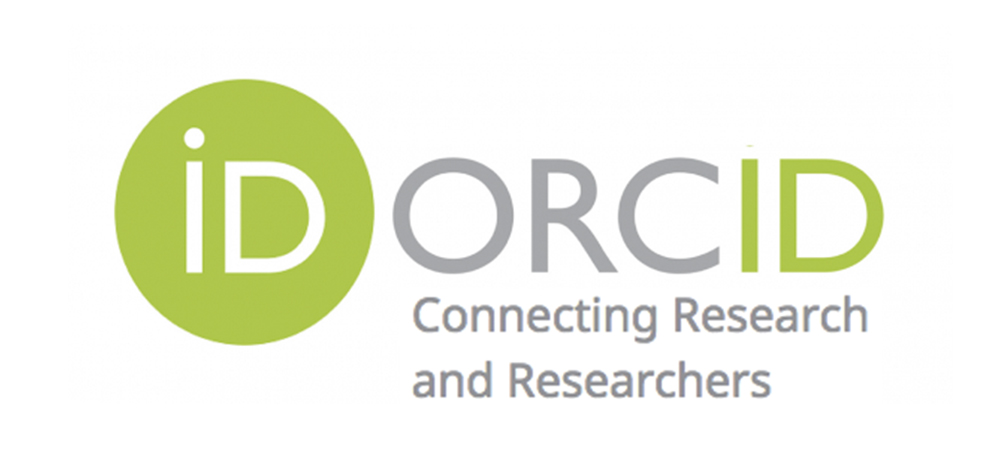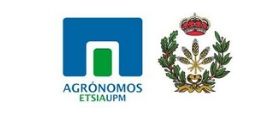Phylogeography and genetic relationship within Erebia neriene (Böber, 1890) in eastern Asia inferred from mitochondrial DNA sequences (Lepidoptera: Nymphalidae)
DOI :
https://doi.org/10.57065/shilap.1059Mots-clés :
Lepidoptera, Nymphalidae, Erebia, COI, gene flow, glaciation, long-distance migration, ND5, AsiaRésumé
Little is known about the genetic relationships within Erebia neriene (Böber, 1890) complexes inhabiting areas outside the Japanese Archipelago. In this study, we investigated genetic variations in E. neriene individuals collected from eastern Asia using mitochondrial sequences to reveal the phylogeny and genetic relationships among E. neriene complexes inhabiting areas outside the Japanese Archipelago. This study revealed greater genetic differentiation and a clear genetic structure among E. neriene neriene and E. neriene scoparia (Butler, 1882) populations. This is the first population genetics study of these subspecies.
Téléchargements
Statistiques globales ℹ️
|
741
Vues
|
120
Téléchargements
|
|
861
Total
|
|
Références
Benjamini, Y., & Yekutieli, D. (2001). The control of the false discovery rate in multiple testing under dependency. Annals of Statistics, 29(4), 1165-1188. https://doi.org/10.1214/aos/1013699998 DOI: https://doi.org/10.1214/aos/1013699998
Bromilow, S. M., & Sperling, F. A. H. (2011). Phylogeographic signal variation in mitochondrial DNA among geographically isolated grassland butterflies. Journal of Biogeography, 38(2), 299-310. https://doi.org/10.1111/j.1365-2699.2010.02398.x DOI: https://doi.org/10.1111/j.1365-2699.2010.02398.x
Excoffier, L., & Lischer, H. E. L. (2010). Arlequin suite ver 3.5: a new series of programs to perform population genetics analyses under Linux and Windows. Molecular Ecology Resources, 10(3), 564-567. https://doi.org/10.1111/j.1755-0998.2010.02847.x PMid:21565059 DOI: https://doi.org/10.1111/j.1755-0998.2010.02847.x
Frenzel, B. (1968). The pleistocene vegetation of Northern Eurasia. Science, 161(3842), 637-649. https://doi.org/10.1126/science.161.3842.637 PMid:17801456 DOI: https://doi.org/10.1126/science.161.3842.637
Honda, K., Honda, Y., Matsumoto, J., Tsuruta, Y., Yagi, W., Ômura, H.. & Honda, H. (2016). Production and sex-pheromonal activity of alkaloid-derived androconial compounds in the danaine butterfly, Parantica sita (Lepidoptera: Nymphalidae: Danainae). Biological Journal of the Linnean Society, 119(4), 1036-1059. https://doi.org/10.1111/bij.12823 DOI: https://doi.org/10.1111/bij.12823
Inomata, T., Uémura, Y., Yago M., Jinbo, U., & Ueda, K. (2010-2013). The current checklist of Japanese butterlies. http://binran.lepimages.jp/. (in Japanese)
Michalakis, Y., & Excoffier, L. (1996). A generic estimation of population subdivision using distances between alleles with special refernce for microsatellite loci. Genetics, 142(3), 1061-1064. https://doi.org/10.1093/genetics/142.3.1061 PMid:8849912 PMCid:PMC1207006 DOI: https://doi.org/10.1093/genetics/142.3.1061
Nagaoka, H., & Xiaoshuan, B. (2017). Butterflies survey in north region of Inner Mongolia, the People’s Republic of China. Yadoriga, 252, 36-50. (in Japanese)
Nakatani, T., Ueda, S., Nishio, S., & Usami, S. (2018). Molecular phylogeny of the genus Erebia (Lepidoptera, Nymphalidae, Satyrinae): species groups inferred from mitochondrial and nucleus gene sequences. Butterfly Science, 12, 27-48.
Nakatani, T., Usami, S., & Itoh, T. (2007a). Molecular phylogenetic analysis of the Erebia aethiops group (Lepidoptera, Nymphalidae). Transaction of the Lepidopterological Society of Japan, 58(4), 387-404.
Nakatani, T., Usami, S., & Itoh, T. (2007b). Phylogeographic history of hte Japanese alpine ringlet Erebia niphonica (Lepidoptera, Nymphalidae): fragmentation and secondary contact. Transaction of the Lepidopterological Society of Japan, 58(3), 253-275.
Nei, M., & Li, W.-H. (1979). Mathematical model for studying genetic variation in terms of restriction endonucleases. Proceedings of the National Academy of Sciences of the United States of America, 76(10), 5269-5273. https://doi.org/10.1073/pnas.76.10.5269 PMid:291943 PMCid:PMC413122 DOI: https://doi.org/10.1073/pnas.76.10.5269
Schmitt, T., & Haubrich, K. (2008). The genetic structure of the mountain forest butterfly Erebia euryale unrabels the late Pleistocene and postglacial history of the mountain coniferous forest biome in Europe. Molecular Ecology, 17(9), 2194-2207. https://doi.org/10.1111/j.1365-294X.2007.03687.x PMid:18266631 DOI: https://doi.org/10.1111/j.1365-294X.2007.03687.x
Schmitt, T., Hewitt, G. M., & Muller, P. (2006). Disjunct distributions during glacial and interglacial periods in mountain butterflies: Erebia epiphron as an example. Journal of Evolutionary Biology, 19(1), 108-113. https://doi.org/10.1111/j.1420-9101.2005.00980.x PMid:16405582 DOI: https://doi.org/10.1111/j.1420-9101.2005.00980.x
Sekiguchi, M., Nakatani, T., Shinkawa, T., & Kogure, M. (2002). Molecular phylogenetic analysis of hte genus Erebia. Transaction of the Lepidopterological Society of Japan, 53(1), 1-11. https://doi.org/10.1665/1082-6467(2002)011[0001:AMPAOT]2.0.CO;2 DOI: https://doi.org/10.1665/1082-6467(2002)011[0001:AMPAOT]2.0.CO;2
Simon, C., Frati, F., Beckenbach, A., Crespi, B., Liu, H., & Flook, P. (1994). Evolution, weighting and phylogenetic utility of mitochondrial gene sequences and a compilation of conserved polymerase chain reaction primers. Annals of the Entomological Society of America, 87(6), 651-701. https://doi.org/10.1093/aesa/87.6.651 DOI: https://doi.org/10.1093/aesa/87.6.651
Tamura, K., Stecher, G., & Kumar, S. (2021). MEGA 11: molecular evolutionary genetics analysis version 11. Molecular Biology and Evolution, 38(7), 3022-3027. https://doi.org/10.1093/molbev/msab120 PMid:33892491 PMCid:PMC8233496 DOI: https://doi.org/10.1093/molbev/msab120
Yagi, T., Sasaki, G., & Takebe, H. (1999), Phylogeny of Japanese papilionid butterflies inferred from nucleotide sequences of mitochondrial ND5 gene. Journal of Molecular Evolution, 48(1), 42-48. https://doi.org/10.1007/PL00006443 PMid:9873075 DOI: https://doi.org/10.1007/PL00006443
Téléchargements
Publiée
Comment citer
Numéro
Rubrique
Licence
(c) Tous droits réservés Hisato Nagaoka, Xiaoshuan Bai, Dmitry Goshko, Batzorig Baljinnyam, Toshiaki Yamamoto, Kaneaki Edo, Shigeru Kitanishi 2025

Ce travail est disponible sous la licence Creative Commons Attribution 4.0 International .
L'auteur conserve ses droits de marque et de brevet sur tout procédé ou procédure figurant dans l'article.
L'auteur conserve le droit de partager, distribuer, exécuter et communiquer publiquement l'article publié dans SHILAP Revista de lepidopterología, avec une reconnaissance initiale de sa publication dans SHILAP Revista de lepidopterología.
L'auteur conserve le droit de procéder à une publication ultérieure de son travail, de l'utilisation de l'article à sa publication dans un livre, à condition d'indiquer sa publication initiale dans le SHILAP Revista de lepidopterología.
Chaque soumission à SHILAP Revista de lepidopterología doit être accompagnée d'une acceptation des droits d'auteur et de la mention de la paternité. En les acceptant, les auteurs conservent le droit d'auteur de leur travail et acceptent que l'article, s'il est accepté pour publication par le SHILAP Revista de lepidopterología, soit autorisé à être utilisé et distribué sous une licence "Creative Commons Attribution 4.0 International" (CC BY 4.0) ce qui permet une utilisation, une distribution et une reproduction sans restriction sur tout support, à condition que l'auteur et la source originale soient mentionnés.
Vous pouvez lire ici les informations de base et le texte légal de la licence. L'indication de la licence CC BY 4.0 doit être expressément mentionnée de cette manière lorsque cela est nécessaire.
À partir de 2022, le contenu de la version imprimée et numérique est soumis à une licence d'utilisation et de distribution "Creative Commons Attribution 4.0 International" (CC BY 4.0), ce qui permet une utilisation, une distribution et une reproduction sans restriction sur tout support, à condition que l'auteur et la source originale soient mentionnés.
Le contenu antérieur de la revue a été publié sous une licence de droit d'auteur traditionnelle; toutefois, les archives sont disponibles en libre accès.
Lors de l'utilisation du contenu de SHILAP Revista de lepidopterología publié avant l'année 2022, y compris les figures, les tableaux ou tout autre matériel sous forme imprimée ou électronique appartenant aux auteurs des articles, les auteurs doivent obtenir l'autorisation du détenteur des droits d'auteur. Les responsabilités légales, financières et pénales à cet égard incombent à l'auteur ou aux auteurs.
En application du Principe de Priorité du Code international de nomenclature zoologique, aucune autre version que celle publiée par l'éditeur ne peut être déposée dans des dépôts, des sites web personnels ou similaires.
